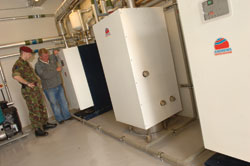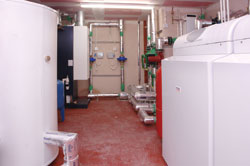Yan Evans, technical director of Andrews Water Heaters and Potterton Commercial, explains the benefits of opting for a centralised boiler plant rather than having individual boilers in each dwelling
Over the past few years there has been a swing towards centralised boiler plants for heating and/or the production of hot water for large multi-dwelling accommodation blocks.
Properties with centralised boilers are being used for sheltered-housing schemes, social- housing developments, student accommodation, MOD living quarters and key-worker accommodation.
Centralised boiler plants are preferable because there are difficulties inherent in having individual boilers sited in each dwelling. Individual condensing gas boilers require a flue, which creates problems - both in the unsightly appearance of the flue itself and the potential visible plumes that are discharged. In addition, annual servicing of the boilers, which is a legal requirement for a landlord, can be difficult and costly.
Gaining access to a dwelling can present a problem, with servicing sometimes having to take place outside normal working hours, or at weekends. This can also be costly for big developments, as much as £150 to £200 per boiler, per service.

At ease: A pair of Andrews condensing Supa-Flo water heaters serves the Rock Barracks, home of 23 Engineer Regiment (Air Assault), a unit of 16 Air Assault Brigade
There are benefits to having a centralised boiler plant. When one is installed in multi-dwelling accommodation, the number of flues is dramatically reduced - just a single flue for some installations. Commercial boilers and water heaters are installed in a plant room external to dwellings, so access for servicing is not an issue. Although the boilers are larger, and appliance-servicing costs may be higher, the overall servicing costs will be lower, as the number of appliances is significantly less.
Gas going directly to the dwellings can be avoided, with mains gas simply piped to the plant room. This has two benefits: it reduces the cost of the gas installation; and is considered safer.
Centralised heating and hot- water plants can easily be integrated with low- and zero-carbon technologies. The diversity of load across multiple dwellings served by a centralised plant offers a higher base load to support technologies such as ground-source heat pumps and combined heat and power (CHP) units. For example, a ground-source heat pump and CHP unit could
support centralised space-heating boilers. The heat pump and CHP unit would act as the lead boiler(s) with high efficiency condensing boilers providing the additional heat required above the output of the low- and zero-carbon technologies. The electricity generated by the CHP unit on-site could be used to power the ground-source heat pump.
The availability of larger-output wall-hung commercial condensing boilers also means centralised plant rooms are smaller than those previously required. This helps to overcome a barrier to central plant rooms - loss of rentable income-generating space.
To manage the heating and hot water coming into the dwelling from the centralised plant room a heat box needs to be installed in each. The heat box acts as a hydraulic interface between the centralised heating and hot water generation and the dwelling. There are two options for how the heating and hot water are supplied to each dwelling.
It can be supplied without heat exchangers, where hot water is generated in the dwelling through the use of an indirect cylinder. Or, it can be supplied with heat exchangers - one to provide a hydraulic break between the centralised plant and the dwelling heating circuit, and the other to convert the centrally produced heating into dwelling hot water. In addition, a heat box will usually include a heat meter for resident consumption-based charging. The cost of heat meters has reduced in recent years, which has also supported the trend back to centralised plant rooms.
Historically, the need to manually read meters in each dwelling has been a high cost. Now heat meters can be read remotely, the costs associated have been dramatically reduced. Heat metering also encourages residents to be more careful about their energy use, as they are charged for what they consume. Metering energy use is beneficial for key-worker accommodation, as sometimes residents - for instance doctors - move around hospitals during the year. Flat-rate energy charging would not be appropriate, due to seasonal variations in energy consumption and heat meters mean everyone can be charged for exactly what they have used.
With the cost, technology and safety benefits associated with moving away from boilers in individual dwellings in a multi-dwelling building - opting, instead, for a centralised plant room - it seems likely the trend will continue to grow over the coming years.

Ashley Gardens Care Centre, Maidstone, has 89 individual suites supplied with heating and hot water by a centralised boiler plant